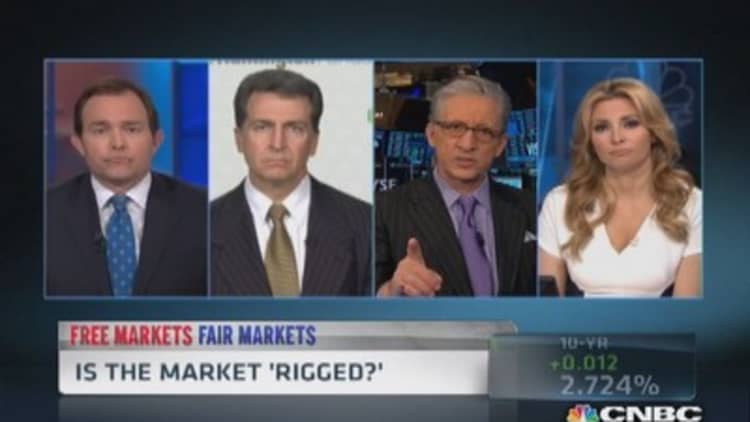"The United States stock market, the most iconic market in global capitalism, is rigged."
That's what Michael Lewis told Steve Kroft on the CBS show "60 Minutes" on Sunday evening. It was a clever, if hyperbolic, way for Mr. Lewis to describe the topic of his important new book, "Flash Boys," a make-your-blood-boil read about the abusive way that high-frequency trading works.
Mr. Lewis's well-crafted narrative highlights a perverse system on Wall Street that has allowed certain professional investors to pay hundreds of millions of dollars a year to locate their computer servers close to stock exchanges so they can make trades milliseconds ahead of everyone else.
(Read more: Michael Lewis and why the stock market is 'rigged')
In some cases, the superfast investors are able to glean crucial information from the stream of trading data flowing into their systems that allows them to see what stocks other investors are about to buy before they are able to complete their orders.
There is only one problem with Mr. Lewis's tale: He reserves blame for the wrong villains. He points mostly to the hedge funds and investment banks engaged in high-frequency trading.
But Mr.Lewis seemingly glosses over the real black hats: the big stock exchanges, which are enabling — and profiting handsomely — from the extra-fast access they are providing to certain investors.
While the big Wall Street banks may have invented high-speed trading, it has gained widespread use because it has been encouraged by stock markets like the New York Stock Exchange, Nasdaq and Bats, an electronic exchange that was a pioneer in this area. These exchanges don't just passively allow certain investors to connect to their systems. They have created systems and pricing tiers specifically for high-speed trading. They are charging higher rates for faster speeds and more data for select clients. The more you pay, the faster you trade.
(Read more: )
That is the real problem: The exchanges have a financial incentive to create an uneven playing field.
This is not to suggest that high-frequency hedge funds and banks aren't complicit; they are. And some may be doing more than simply taking advantage of the rules. Eric T. Scheneiderman, New York's attorney general, recently began an investigation into high-frequency trading. "There are some things here that may be illegal," he told Bloomberg News. "There are some things that may now be legal that should be illegal or that the markets have to be changed."
More from The New York Times:
A Question of What's a Reasonable Reward
Hedge Fund Spars With a Nameless Blogger
Scrutiny for Wall Street's Warp Speed
If — and hopefully when — the rules get changed, the new requirements will probably have to be carried out by the stock exchanges, not likely the investors. And thosenew rules could force the exchanges to shut down or modify the special lane of traffic they have created for high-frequency traders. Just as important, the exchanges will probably have to find a way to build speed bumps into the system so that all investors are able to trade at the same time, no matter what superfast fiber-optic cable they build to gain an advantage. That would be much like the system developed to slow down trading by the protagonist of Mr. Lewis's story, Brad Katsuyama, who has built an alternative electronic exchange called IEX.
Of course, while Mr. Lewis lays out a black-and-white case against high-speed trading, the right regulation is complicated.
On "60 Minutes" Mr. Lewis made it seem simple: "The insiders are able to move faster than you. They're able to see your order and play it against other orders in ways that you don't understand. They're able to front run your order."
The problem that regulators are going to have to confront in writing new rules is that the high-frequency trading problem isn't a simple David vs. Goliath story. It isn't the neophyte retail investor on E-Trade vs. the sophisticated high-frequency trader.

Most of the big money that high-frequency traders make is by competing against other big institutions. Mr. Lewis argues that high-frequency traders, with their unfair advantages, are putting the little guy's pension fund in jeopardy. That may be true, but only partly: Where do you think high-frequency trading firms are getting the money to invest? Pension funds. So it gets complicated very quickly.
Stock exchanges that cater to high-frequency traders often defend the practice by saying that such trading adds liquidity to the market and lowers the prices that all investors pay. To some degree, this argument is accurate. The amount that investors pay has come down remarkably over the last several decades. Defenders say that the market has always included some form of middleman extracting a piece of every order. The high-frequency traders just do this more efficiently.
CBS Michael Lewis, the author of "Flash Boys," discussed high-frequency trading on "60 Minutes."
Oddly enough, Goldman Sachs, one of the earliest high-frequency traders, has come out in favor of new rules to make the system fairer and more stable. Still, if the firm were serious about its position, it should consider dropping some of its clients or pressuring them to change their ways: Goldman is an underwriter of a coming initial public offering for Virtu Financial, which specializes in high-frequency trading.
Then, there is the question of the responsibility of the Securities and Exchange Commission. Until recently, the agency has not just looked the other way about these high-speed arrangements, but has actively encouraged them. In recent months, the S.E.C. has finally begun to consider whether the rules should be changed.
Mr. Lewis is putting a spotlight on an issue that, if corrected, will hopefully help the markets become a bit more fair. (There remain a host of other problems that still make it "rigged.") But it is important that the regulators address the real culprits, not just the easy targets.

